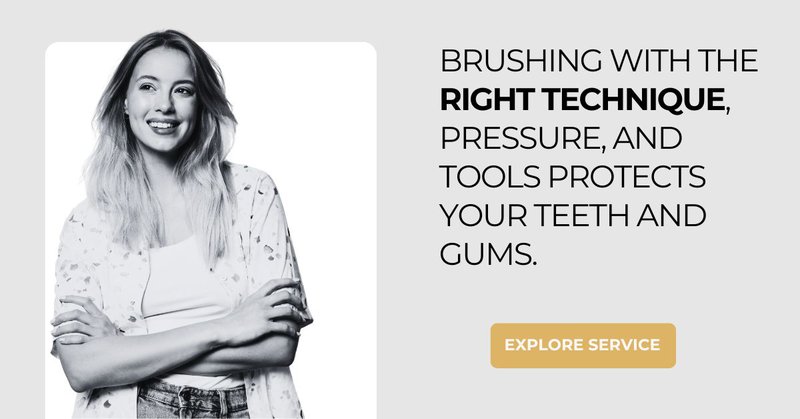Brushing your teeth seems simple, but are you sure you're doing it correctly? Proper brushing techniques aren’t as simple as they seem. Many people use too much pressure, miss key areas, or choose the wrong technique. If you’re not following proper brushing techniques, it can lead to cavities, gum disease, and stains. The good news? A few small changes can make a big difference. So, understanding the best way to brush for a healthier, brighter smile is vital. Let’s fix those bad habits today!
Key Takeaways:
- Brush Preparation: Wet a soft-bristled toothbrush, apply a pea-sized amount of fluoride toothpaste, and charge electric brushes as needed.
- Brushing Technique: Hold the brush at a 45-degree angle, use gentle, small strokes, and cover all tooth surfaces, including the tongue.
- Commonly Missed Areas: Focus on back molars, gumline, and behind teeth. If you have braces, clean around brackets and wires.
- Brushing Time: Brush for at least 2 minutes and replace your toothbrush every 3–4 months.
- Brushing Pressure: Too much pressure can damage enamel and gums. Use a soft-bristled brush and light strokes.
- Toothpaste Choice: Use fluoride toothpaste; avoid abrasive options like charcoal or baking soda.
- Brushing Methods: Bass (plaque removal), Stillman (gum health), and Charter (braces-friendly).
- Electric Toothbrush Use: Let the brush do the work, apply light pressure, and follow the built-in timer.
- Children’s Brushing: Use the Fones technique (circular motions) for easy learning. Monitor toddlers and use fluoride toothpaste sparingly.
- Brushing Timing: Brush before breakfast to prevent acid damage or wait 30–60 minutes after eating. Always brush before bed.

What Are the Correct Steps for Brushing Your Teeth?
How to Prepare Your Toothbrush Before Brushing
The first step to proper brushing techniques starts with wetting your toothbrush slightly. This helps distribute the toothpaste evenly. Use a soft-bristled toothbrush to protect your gums and enamel. Apply a pea-sized amount of fluoride toothpaste to the bristles. More toothpaste does not clean better and is often wasteful. If you use an electric toothbrush, confirm it is charged and ready to use before you begin.
Correct Motions and Pressure for Effective Cleaning
Another staple of proper brushing techniques is to hold a toothbrush at a 45-degree angle to your gums. This angle helps remove plaque and food buildup near the gumline. Use small, gentle strokes—scrubbing too hard is unnecessary and harmful. Too much pressure can harm your gums and wear down enamel. Move the brush back and forth on each tooth's outer and inner surfaces. For the chewing surfaces, use a firmer back-and-forth motion to remove any trapped food particles.
To clean the inside surfaces of your front teeth, tilt the brush vertically and use up-and-down strokes. Brushing your tongue is important—it removes bacteria and keeps your breath fresh.
Which Areas of the Mouth Need Special Attention for Proper Brushing Techniques?
Many people tend to miss the back molars and the gumline. Plaque builds up easily in these areas, leading to cavities and gum disease. Spend extra time brushing behind your back teeth and along the gumline. If you have braces or dental work, take care to clean around wires and brackets.
If you are following proper brushing techniques, it should take at least two minutes. Many people do not brush for long enough, so using a timer or a toothbrush with a built-in timer can help. Your toothbrush should be replaced every 3–4 months to remain effective.
For more expert tips on oral care, check out our blog. Visit the American Dental Association’s guide for more details on proper brushing.
Will Proper Brushing Techniques Damage Teeth?
Brushing incorrectly can harm your teeth and gums. Many people press too hard or use the wrong brush, leading to sensitivity and gum recession. Follow these steps for safe and effective cleaning.
Use the Right Pressure for Proper Brushing Techniques
Brushing too hard does not clean better—it damages enamel and irritates gums. The pressure should be enough to remove plaque but not strong enough to cause discomfort. If your toothbrush bristles fray quickly, you are pressing too hard.
Choose a Soft-Bristled Toothbrush
Hard bristles can wear down enamel and worsen gum recession. A soft-bristled toothbrush offers effective cleaning while protecting your teeth. If you have sensitive gums, look for brushes labeled as "extra-soft."
Brush at a 45-Degree Angle
Holding your brush at a 45-degree angle allows you to reach the plaque where your teeth and gums meet. Use short, gentle strokes, rather than scrubbing aggressively.
Don’t Forget Your Gums and Tongue
Brushing gums lightly keeps them healthy. Avoid excessive scrubbing, as it can cause irritation. Bacteria can also accumulate on your tongue, leading to bad breath. Brushing your tongue daily helps reduce this buildup.
Pick Fluoride Toothpaste, Not Abrasive Ones
Fluoride strengthens enamel and helps prevent cavities. Avoid toothpaste with harsh particles, such as charcoal or baking soda, as they can wear away enamel over time.
Replace Your Toothbrush Regularly
A worn toothbrush is less effective. Change yours every three to four months or sooner if the bristles become frayed.
By following these steps, you can clean your teeth thoroughly and protect your gums. Check out the list of ADA-approved toothbrushes and toothpaste.
How Should You Brush Your Teeth With an Electric Toothbrush?
An electric toothbrush can clean more effectively than a manual one when using the proper brushing technique. The key is to let the brush do the work, avoiding excessive movement or pressure.
Are Electric Toothbrushes Better Than Manual Ones for Proper Brushing Techniques?
Yes, electric toothbrushes remove plaque more effectively. Research shows they decrease plaque and help prevent gum disease. Built-in timers help ensure you brush for the full two minutes, and pressure sensors prevent overly aggressive brushing that could damage your gums and enamel.
Best Electric Toothbrush Techniques for Thorough Cleaning
Use the Modified Bass technique with an electric toothbrush. Hold it at a 45-degree angle to the gumline. Gently guide the brush across your teeth and gums without applying extra pressure. Let the vibrations and rotations clean the surfaces.
Divide your mouth into four sections. Spend 30 seconds on each, covering all surfaces of each tooth. Tilt the brush vertically for better access to the inside edges of the front teeth.
Using Pressure Sensors and Timers for Better Results
Most electric toothbrushes feature pressure sensors that alert you when you’re pressing too hard. Overbrushing can wear down enamel and contribute to gum recession. If your brush has this feature, adjust your pressure as needed.
Use the built-in timer to ensure you brush for two full minutes. Some brushes pause briefly every 30 seconds to remind you to switch sections, helping cover every area properly.
To maintain performance, replace your brush head every three months or when bristles start to fray. This keeps your brush working effectively and promotes good oral health.
Should You Brush Before or After Meals?
The best time to brush depends on what you eat.
Brushing before breakfast clears overnight plaque and protects teeth. Bacteria in your mouth use sugars from food to create acids, which weaken enamel. Brushing first removes bacteria and adds fluoride for protection.
Brushing after breakfast removes food debris but comes with risks. Acidic foods like citrus and coffee soften enamel. Brushing immediately can wear down the enamel. Waiting 30 to 60 minutes allows your enamel to re-harden before brushing. In the meantime, rinsing your mouth with water can help clear acids.
Brushing before bed is essential because saliva production decreases at night, allowing bacteria to thrive. Cleaning your teeth thoroughly before sleeping reduces the risk of decay and gum problems.
For the healthiest routine, brush before breakfast and before bed. If brushing after meals, allow time for acidic foods to dissipate first.
How Often Should You Replace Your Toothbrush?
You should get a new toothbrush every three to four months. Worn bristles clean less effectively, and bacteria accumulate over time.
If your bristles are bent or flattened, they won’t clean well. A toothbrush that feels rough on your gums or has a bad smell should be replaced. If you’ve been sick, switching to a new brush can help avoid reinfection.
Using fresh, soft-bristled toothbrushes helps maintain strong enamel, healthy gums, and effective plaque removal.
Brushing with the correct technique, pressure, and tools protects your teeth and gums. Minor improvements in your routine can help prevent cavities and gum disease, keeping your smile healthy for years.
Have You Been Following the Proper Brushing Techniques? Smile Dailey Modern Dentistry Can Help
If you are concerned you haven’t been brushing your teeth the right way or frequently enough, contact us today. We will schedule an exam to determine if your teeth are in good shape. Don’t neglect your smile; get in touch right away.

